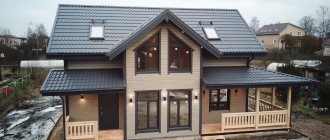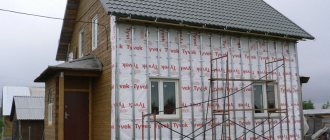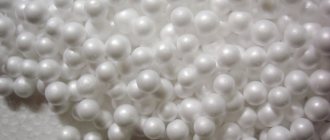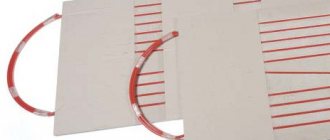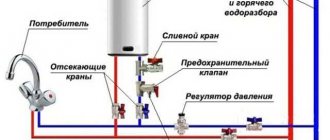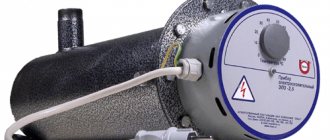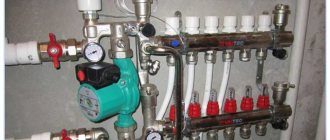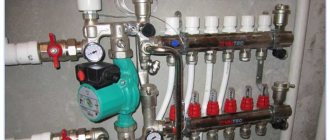Hello dear readers.
I continue the story about my construction project, today I will tell you how I made wind protection for my house, the whole process of installing it, as well as its role in a frame house. Let's look at mistakes when choosing a membrane, installation, as well as the consequences of misunderstanding its operation.
Wind protection for the walls of a frame house plays a huge role; the condition of the insulation and comfortable living conditions in the house depend on it.
Let's start with a small outline of the article:
- About Us
- How does wind protection work?
- Membrane operating principle
- Role in a frame house
- Errors in film application
- What types of membranes are there?
- Wind protection installation technology
- How it was done for me
- What I might change
Here we go?
About Us
My first interview appeared on the Internet; I gave it to a very talented teacher, Sergei Bondarenko, who, in addition to teaching students, also runs a good website dedicated to teaching computer literacy.
In it you can learn a little about me, about my life, and how I myself came to IT technologies. Read, judging by the comments, the interview was a success.
Content
- Laying windbreaks on the floor
- How to lay a windbreak on a roof
- How to install windbreaks on walls
- Is the windbreak attached to the ceiling?
Windproof films of different types are laid in different ways:
- Simple wind protection. These are perforated single-layer films that can be placed on either side of the insulation, as they have double-sided vapor permeability.
- Wind and moisture protection. These are two-layer films that are laid with the moisture-repellent side facing out. This side is smooth, often with manufacturer’s markings or painted in a different (non-white) color.
- Superdiffusion membranes. This material has a multilayer structure with high water resistance and vapor permeability. It is necessary to lay the membrane on the outside of the insulation and only with the marked side facing out.
How does wind protection work?
Windproof film actually performs two functions. Not only does it prevent air masses from penetrating into the insulation when there is wind, but it also acts as a moisture barrier.
A separate type of film is used for arranging insulated roofs. Such films are often called under-roofing membranes, by the way, for some reason many builders neglect them, as it turns out in vain...
Roofing membrane
The windproof membrane consists of polymer fibers sintered in a special way. The film itself is designed in such a way that on one side it is smooth and does not allow moisture from the street to penetrate into the house, on the other it has a rough surface.
Pros and cons of windproof film
Advantages of the material:
• environmental friendliness (there are no harmful and toxic substances in the composition);
• fire resistance (achieved thanks to special additives);
• ease of use (installation technology does not require the use of special equipment);
• moisture resistance;
• does not lose properties under the influence of ultraviolet radiation;
• elasticity allows you to avoid deformation during installation;
• does not change quality and characteristics due to sudden temperature changes;
• long operating period.
Among the disadvantages not of the membrane itself, but of its application, it can be noted that incorrect installation leads to a deterioration in the thermal properties of the facade. A loose fit of the film to the insulation layer provokes the formation and accumulation of condensation on the insulation side.
Also, some builders forget about the need to leave a ventilation gap between the membrane and the cladding.
Role in a frame house
For a frame house, a windproof membrane is of great importance. Since insulation is used in such a house, there is a need to protect it from moisture and blowing. Probably many have seen what happens to insulation when it lies in the open air.
The fibers fluff up, the trapped moisture does not want to leave at all, and freezes in winter, which leads to the loss of the thermal insulation properties of any mineral wool insulation.
This has little to do with polystyrene foam; it is not afraid of moisture and is not subject to moisture accumulation. Therefore, many may consider the use of a membrane in a house with foam insulation unnecessary.
But this is a misconception; the film also protects the frame of the building from atmospheric influences, and fulfills its function of protecting from the wind. This is very important in any house, even a log house, especially a log house.
Consequences of refusing vaporization
A lack of understanding of the importance of vapor barrier for a roof often leads to attempts to save money or speed up the construction process. Many users believe that the material can be installed later if the need arises
Other owners rely too much on ventilation. They are confident that increased air exchange in the attic will help remove moist air and solve all problems. However, in practice, the lack of vapor protection affects the same way. Condensation appears, the heat insulator gets wet, and the rafters rot.
The biggest danger is that the process proceeds quite smoothly. The owner observes the condition of the attic for a week and draws conclusions about the normal condition of the insulation pie. The cladding is installed, the room is finished and put into operation. This deprives the user of the ability to control the condition of the materials hidden behind the skin. When destructive processes become apparent, the problem becomes critical. Usually a major overhaul or complete replacement of rafters, roofing, and other roof support elements is required.
Errors in film application
Very often, inexperienced builders make mistakes when choosing and installing wind protection for a home. A common occurrence is the use of a vapor barrier on the outside of the house. People simply do not understand the principle of film operation, and they think that a house can be wrapped in any film.
When purchasing, carefully look at what kind of film they offer you! There are not always smart sellers, and you can easily buy a membrane designed for vapor barrier.
I myself have seen such houses, a pitiful sight, but they are already covered with siding or, even better, metal profiles. When using barrier instead of a wind barrier, moisture is not removed from the wall structure and falls into condensation.
As a result, the walls get wet, and if it is a frame house, then the insulation is completely damaged, and if it is a log house, then hello fungus, mold and rot.
Another mistake is using corrugated sheets as the façade of a house and laying it directly on the wind- and moisture-proof membrane and, accordingly, on the insulation. The film simply stops performing its functions and condensation occurs again.
Make a ventilated gap located vertically between the facade and the membrane. This will allow the vapors and moisture that appears on the membrane to evaporate freely, and you will protect yourself from the problems described above.
Main manufacturers
There are a lot of manufacturers of wind and moisture protective membranes in the world - all specialized companies produce this material. The main supply of such products to the world market comes from the countries of Southeast Asia.
However, there are a sufficient number of our own companies operating in our country. Their materials are in no way inferior to the best European samples, but their price is much lower and more accessible to the mass buyer. Therefore, our users prefer products from domestic companies. The most popular are:
- Isostrong
- TechnoNIKOL
- Nanoizol
- Ondutis
- Izospan
- Rockwool
Some Western companies have their own production facilities in our country and supply high-quality products to the market. At the same time, they are forced to maintain the average price level, otherwise the competitiveness of their products will be lost. Therefore, on sale you can find materials of domestic production, but offered under Western brands.
In addition, some European companies are represented on the market. Their products are of high quality, but the cost is much higher than that of products from Russian manufacturers. Since the difference in quality is insignificant, buyers prefer material with an optimal price-quality ratio.
What types of membranes are there?
There are a huge number of windproof films on sale. They all differ both in price and quality. If you don’t want to take risks on your home, then don’t skimp. A high-quality membrane cannot be cheap.
I can divide films into three types:
- Cheap membranes look very similar to covering material; I would not use them at home. Seal up a shed or a garage, or use it as a flooring under loose insulation on horizontal surfaces.
- More expensive and high-quality windproof films with different surface structures and high density. I used this one for the walls of the house, brand Ondutis A120.
I bought such a membrane.
It is the best thing I have ever held in my hands that is available for sale in our city. Of course not Tyvek, but still a pretty thick film. (If there was, Tyvek would have taken it) - Superdiffusive membranes. These films are used for insulated pitched roofs. They absolutely do not allow water to pass through from the outside to the inside, and easily release steam to the outside. Often made in multilayers to obtain appropriate properties. Well, of course, you can also use them on walls. They are absolutely not blown by the wind.
By category
First of all, you must follow the manufacturer's instructions, which clearly describe which side to lay the windbreak on. If there is no such instruction, there are a number of general recommendations applicable to windproof films:
- the wind protection spreads towards the insulation with the “fleecy” side, unless otherwise specified in the instructions;
- if both sides are the same, the film is attached with the manufacturer’s logo on the outside;
- wind protection without markings and distinctive qualities of one of the sides can be installed in any convenient way.
Manufacturers often roll rolls in such a way that the wind protection can be laid as simply as possible - as the roll unwinds.
Wind protection installation technology
Before you begin installing the windproof membrane, prepare:
- The required amount of film, counting the squares of the walls.
- Stapler and staples, staples still in your pocket, when you are holding a sheet four meters long, you really don’t want to run after the staples that have run out.
- Scotch tape for gluing canvases. Look for the best one recommended for these purposes.
- An assistant, preferably more than one, especially on the roof.
The principle of laying film on both walls and pitched roofs is almost the same.
- We roll out the strip along the wall of the house to the required length, check for correct positioning with the smooth side facing out (in general, the film should indicate which side is facing out, so if this is not the case, then read the documentation for the membrane)
- We stretch the wind protection along the wall of the house without fanaticism, then punch it with a stapler to the studs or slab sheathing, depending on the structure of the building.
- We stick special double-sided tape to the upper edge of the film, without removing the paper from the tape. We will later pull it out from under the top film.
- We roll out the next row of film and also shoot it. We continue until the wall is completely filled from bottom to top.
- We pull out the paper from the tape and carefully glue the membranes together.
- We nail vertical bars to organize a ventilation gap, with the frequency required for a specific type of facade. It is on these slats that we attach the façade of the building.
Ventilation gap block
It is important to close the windbreak as soon as possible; over time, the film loses its properties as a result of exposure to sunlight. Each film has its own timing, but I would close it in the first month after installing the membrane.
For the roof, everything is done in the same way, from bottom to top, and with sizing. Just be careful, it is very inconvenient to climb the rafters and click the stapler. You need long arms or a helicopter)))
Material selection criteria
One of the main parameters for choosing building materials for a home is environmental friendliness. Some types of wind protection are used for interior work. The absence of toxic emissions is especially important here. Information about this can be found in the certificates for specific samples.
The next criterion is technical indicators. Here we consider options for which wind protection to choose for the roof and facade. Important parameters are strength, resistance to ultraviolet rays, and temperature limits acceptable for operation. In the case of interior work in wet rooms, vapor permeability is additionally taken into account.
The third point is durability. In most cases, it is important that the material lasts as long as or longer than the structures being protected. But there are projects where isolation is needed temporarily. Budget solutions are more relevant here.
Glassine Source ygozapad.ru
How it was done for me
In my house I used two types of membranes; for the walls I used an ordinary windproof film, and for the inclined parts of the attic I used a superdiffusion film.
When insulating an attic, the use of a superdiffusion membrane is more relevant. When laying insulation, you don’t have to worry about the gap between the film and the insulation, but lay the mineral water closely. This gap is necessary when using conventional windproof film.
House wall
I stretched the canvas as described, started from one corner and walked around the whole house with the roll, simultaneously fastening the film to the racks. When I finished the first row, I started on the second, and so on until the very top.
It was interesting to attach the membrane to the rafters, the roll is wide, the rafters are high, no matter how we twisted it, we did it! Two rows of membrane on each superdiffusion slope, and one row of regular wind protection. I placed the usual one where the uninsulated part of the slope is.
Three rows of wind protection
For gluing I used adhesive tape, from the same Ondutis company, I want to say right away that it dries in the sun in a moment, and everything comes off. Where I covered it with siding did not come off, and everything is sticking. In theory, the adhesive substance of these tapes should not dry out under any circumstances... I glued it again after installing the siding, it seems to be holding.
Peculiarities
Wind protection of walls plays an important role in any construction. The need for its arrangement is explained by the fact that heat tends to leave the building; there are several reasons for this.
- Infiltration is the flow of heated air through cracks, as well as cracks and pores in the walls and floor.
- Ventilation - even the most durable thermal insulation materials have micropores, so air masses spread throughout the entire internal volume of the insulation. This reduces its functionality; this figure can reach 90%.
That is why it is extremely important to use wind protection, thanks to which you can regulate the temperature in the room. In addition, the wind and moisture protective film prevents the appearance of fungi and mold that are dangerous to life and health, which invariably appear when condensation occurs
There is an opinion that wind protection and vapor barrier are the same thing, but this is not so. The materials have a similar effect, however, the differences between them are very significant.
A vapor barrier is needed to protect the insulation layer from wet condensation coming from the room. It is used in construction as an addition to thermal insulation coating. Wind protection is indispensable in situations where it is necessary to protect the structure from the adverse effects of wind, precipitation and other weather phenomena. Ventilated facades have the property of allowing steam to pass through, so liquid in the form of condensation does not accumulate inside the insulation and maintains its functional characteristics.
Types of vapor barrier
Let's first understand what a vapor barrier is. This is a material that belongs to two types - preventing moisture from heated air from penetrating further or allowing it to pass through. In fact, the first type is a film, the second is a membrane. However, these concepts are often confused due to a lack of understanding of the difference, and due to the difficulty of translating instructions from foreign manufacturers
A one-way membrane is a layered material with special properties. It allows water molecules to pass through only in one direction; its thickness is comparable to the size of the molecule. Of course, they are attached so that the steam-permeable layer faces the warmer room - inside the house. In such cases, manufacturers ALWAYS indicate which side to place the membrane during installation and mark the required surface.
Double-sided membranes allow steam to pass through on both sides, so the mounting side is not important. The whole “trick” is in the special structure of the material.
At the same time, the membrane itself has low strength, therefore, to improve performance characteristics, it is supplemented with a layer of textile or non-woven material on one or both sides. The structure may also have a reinforcing layer in the form of a mesh, a reflective layer of aluminum foil. This type of vapor barrier is called “reflective”.
Does vapor permeability change when changing sides?
All of the above modern barriers are divided into the following types:
- for one-sided installation, which need to be rolled out with a certain side up and it is recommended not to confuse them;
- and for double-sided use, usually with membranes that can be laid on either side.
You will be interested to know that the first membranes, which had the same properties as modern roofing membranes, were used in astronautics. And from there they were borrowed for construction and the national economy. But until recently, there were not as many problems with their installation as there are today.
There is a strong opinion among ordinary people: if you lay the vapor barrier to the roof insulation “on the wrong side,” then the entire structure will not last long. In fact, the correct choice of side affects exclusively the service life of the interior finishing of the roofing pie, because the rough side has the same abilities as the smooth side and has absolutely the same vapor permeability. But how much it will retain droplets of condensate is a little-studied question.
Izospan D
High-strength, completely moisture-proof waterproofing material. Polypropylene sheet with one-sided laminated polypropylene coating. The versatility of the moisture-vapor-proof material implies widespread use in construction technologies for the construction of any type of structure.
Izospan D successfully withstands moderately strong mechanical loads, is resistant to tearing, withstands strong gusts of wind, and in winter copes with heavy snow loads. In comparison with other similar films, Izospan D has gained fame as the most durable and reliable option.
